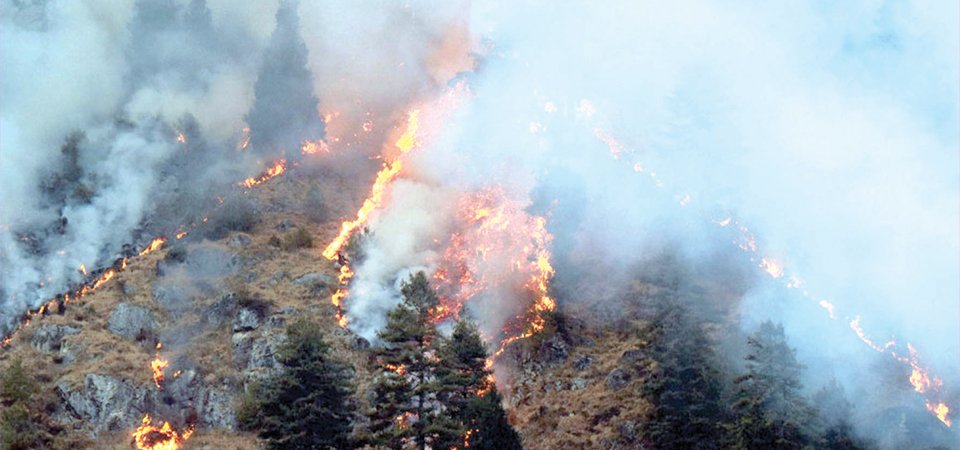Increasing incidents of forest fires add to rising pollution

By Chadani Hamal, Kathmandu, Mar. 31: The forest fire has become the prominent cause of air pollution in different countries including Nepal.
With the smoke emanating from forest fires covering the atmosphere, other pollutants are mixing and pushing the rate of air pollution higher in Nepal and other countries. Forest fires are more intense in Asia and Central Asia than in any other countries in Europe and the North American countries.
Experts have pointed out that a collective global effort is needed rather than a single effort to control the fires that have emerged as outbreaks in this period of pre-monsoon drought.
Similarly, the forest areas of North and South America and Australia are not untouched by fire. The pressure of fire is increasing in Asia, India, Thailand, Myanmar, Sri Lanka, Bangladesh, Pakistan, and other countries.
Sundar Sharma, an expert on forest fire, said, “Forest fire is becoming a burning issue not only in Nepal and Asia but also in the world as the pressure of fire incidents are on the rise”
As Sharma said, NASA's satellite, which is observing the world's fires, has released a picture which shows a large area of the earth being hit by forest fires.
According to Sharma, research experts are involved in collecting data on fire ablaze not only in countries but also in continents.
From the pictures, it has been determined that Asia and Africa are more grappled by the fire whereas Asia has become the ‘fire hub’ lately, said expert Sharma.
The forest fire identification and monitoring system has shown that fires have started in 200 places in the last 24 hours.
Expert Sundar Sharma said, “Nepal should now seek the help of firefighting helicopters from neighboring countries to put out the widespread fire.”
While pointing out that the fire season in Nepal is yet to start, Sharma said that the fire could turn into an outbreak in the coming days if such assistance is not provided in time to save 45 percent of Nepal's forest resources.
From April, it can be even more intense and frightening. Massive fires cannot be controlled by human efforts alone. Firefighters from the U.S. helped put out the blaze in Canada and Australia.
Only global cooperation can prevent such disasters, says Sharma. However, in South Asia, the practice of collective action by various countries to avoid disasters, including fires, is rare.
He emphasised that all countries should start the process of collective effort with national and various international bodies against the emerging adversity.
Sharma suggested to help each other out at the difficult time with what they possess. Some can support with finance and some by other needful resources.
H viewed that cooperation with neighbouring countries could help Nepal in equipping, training and empowering human resources against forest fires in Nepal.
At a time when the whole of Asia and Africa is on fire, it would be wiser for Nepal and other countries to move forward in a joint effort rather than trying unsuccessfully to extinguish the fires of their country by a single effort, Sharma said.
He is working on a firefighting strategy on behalf of the Government of Nepal. For this, Sharma has been appointed as the joint expert of the Forest Department, National Disaster Risk Reduction and Management Authority.
According to Bharati Pathak, Chief of the Federation of Community Forest Users' Groups (FECOFUN), human resources have been used to put out fires in many community forests in Nepal. The method used to control the fire is to pour water from a bucket, soak a sack and throw it in the fire, throw sand, hit the fire with a banana soup has been appointed to put out the raging fire of Nepal.
Recent News

Do not make expressions casting dout on election: EC
14 Apr, 2022
CM Bhatta says may New Year 2079 BS inspire positive thinking
14 Apr, 2022
Three new cases, 44 recoveries in 24 hours
14 Apr, 2022
689 climbers of 84 teams so far acquire permits for climbing various peaks this spring season
14 Apr, 2022
How the rising cost of living crisis is impacting Nepal
14 Apr, 2022
US military confirms an interstellar meteor collided with Earth
14 Apr, 2022
Valneva Covid vaccine approved for use in UK
14 Apr, 2022
Chair Prachanda highlights need of unity among Maoist, Communist forces
14 Apr, 2022
Ranbir Kapoor and Alia Bhatt: Bollywood toasts star couple on wedding
14 Apr, 2022
President Bhandari confers decorations (Photo Feature)
14 Apr, 2022










